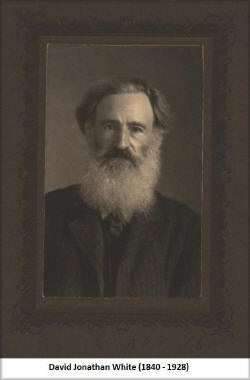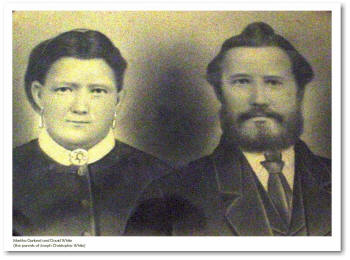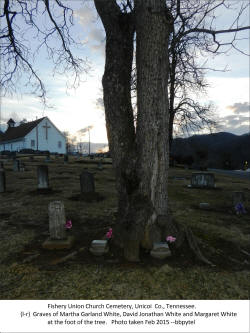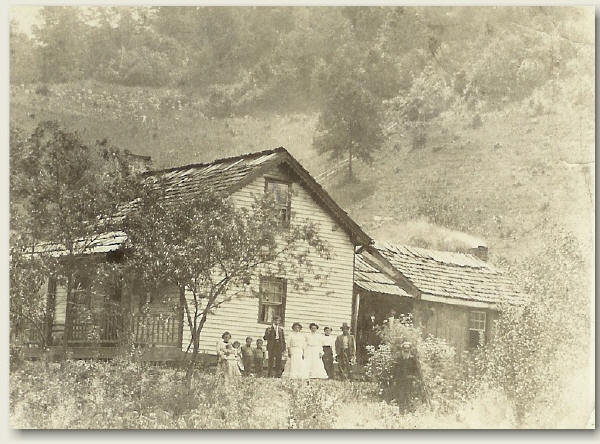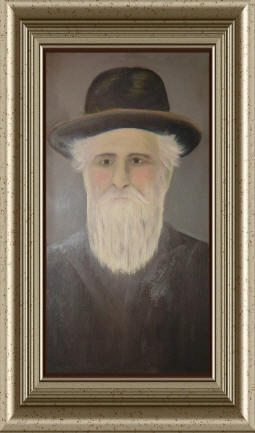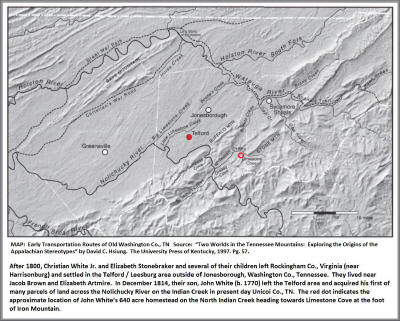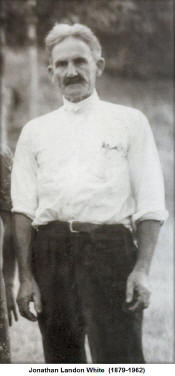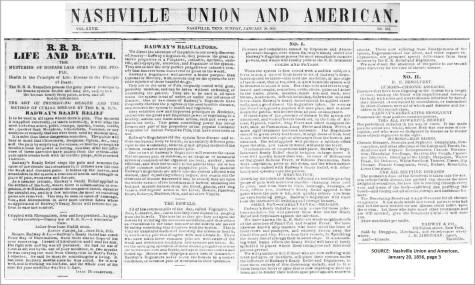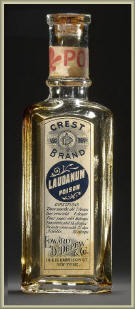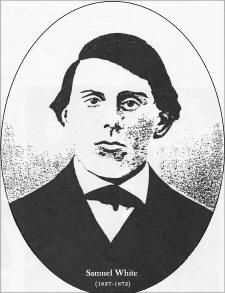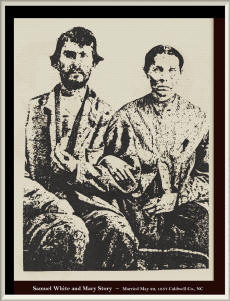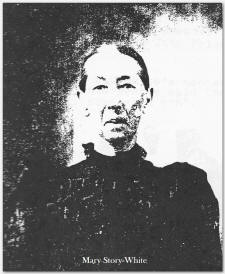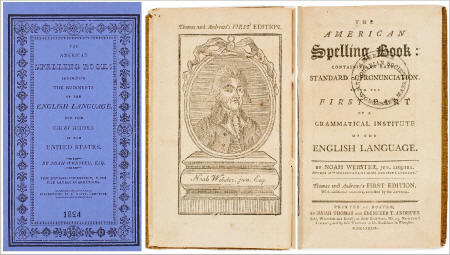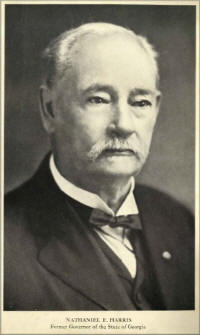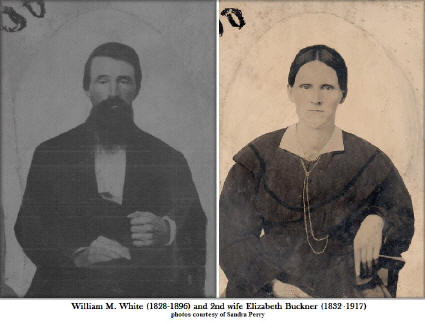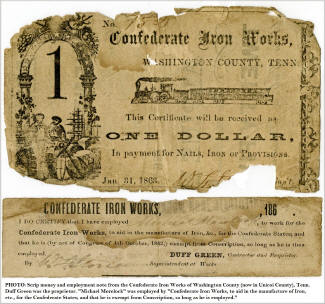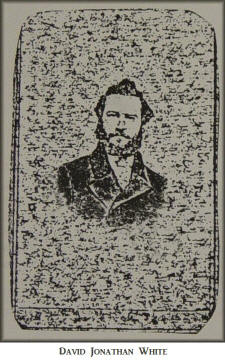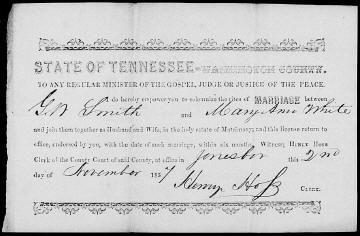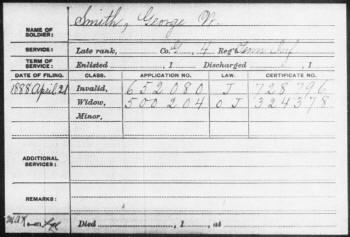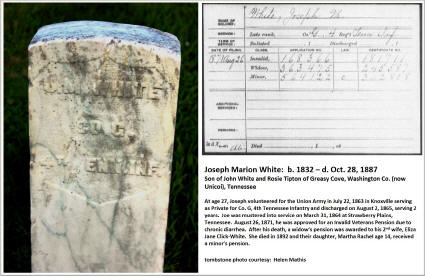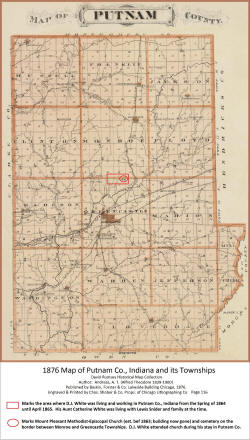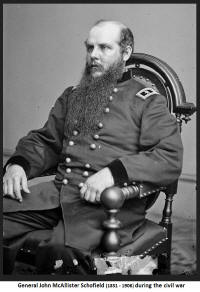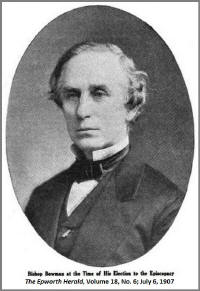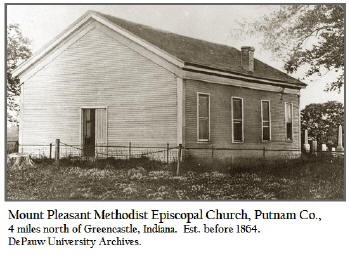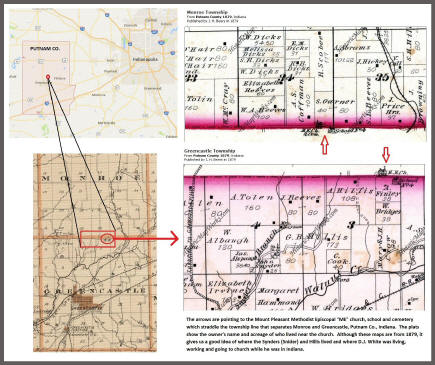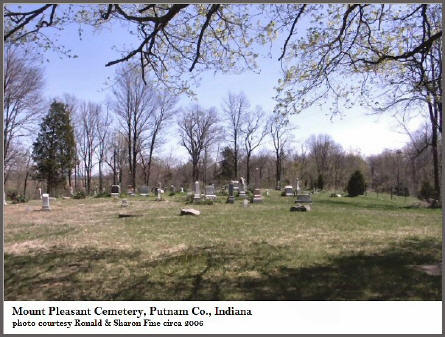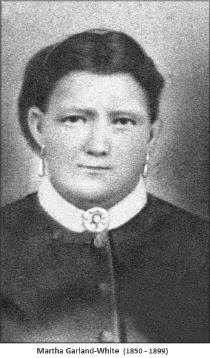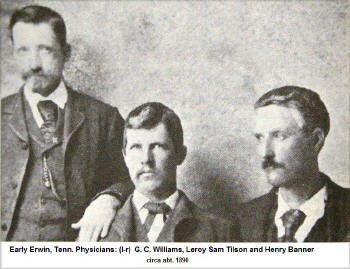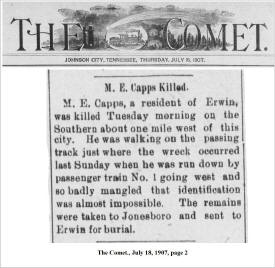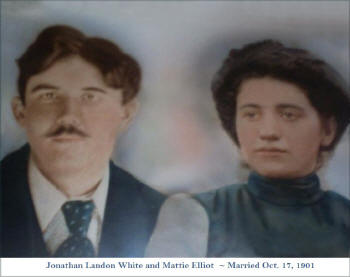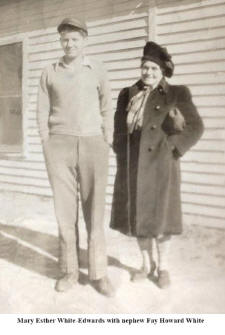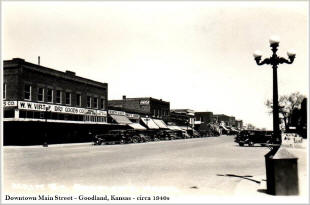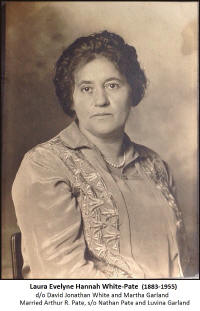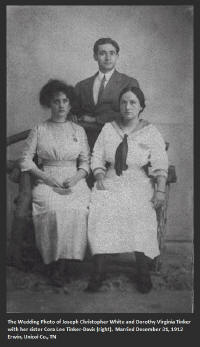“I have written a genealogy of the old set of the White family
running back to old Christian White my great grandfather and Elizabeth
Stonebraker my great grandmother. Christian White married Elizabeth
Stone Braker. Both came from Germany after the Revolutionary War. They
settled in Hagerstown, Maryland. Came to old Virginia, then to Washington
County, Tennessee.”
NOTES / COMMENTARY: To better understand the following commentary, here is
a mapping of D.J. White's maternal ancestry which
goes back to the Knussli/Kneisley line from Switzerland:
 David
Jonathan White [1840 - 1928] s/o >
David
Jonathan White [1840 - 1928] s/o >
 Margaret White [1822 - 1854] (and unknown father)
d/o >
Margaret White [1822 - 1854] (and unknown father)
d/o >
 John White [1770 - 1850] (and 1st wife, Margaret Odell/Odle)
s/o >
John White [1770 - 1850] (and 1st wife, Margaret Odell/Odle)
s/o >
 Christian White Jr. [1746 - 1810] (and Elizabeth
Stonebraker b. abt. 1753) s/o >
Christian White Jr. [1746 - 1810] (and Elizabeth
Stonebraker b. abt. 1753) s/o >
 Christian
White/Wise Sr. [1715 - 1747] and Barbara Miller [1721 - 1777] d/o >
Christian
White/Wise Sr. [1715 - 1747] and Barbara Miller [1721 - 1777] d/o >
 Michael Miller [1690's - 1739] and Barbara Kneisley [1703 - 1777] d/o >
Michael Miller [1690's - 1739] and Barbara Kneisley [1703 - 1777] d/o >
 Antonius Kristopher Kneisley/Knussli [1647 - 1743] (and Magdalena
Hempstead) s/o >
Antonius Kristopher Kneisley/Knussli [1647 - 1743] (and Magdalena
Hempstead) s/o >
 Hans Knussli
[1624 - ?] (and Elisbeth Mueller)
Hans Knussli
[1624 - ?] (and Elisbeth Mueller)
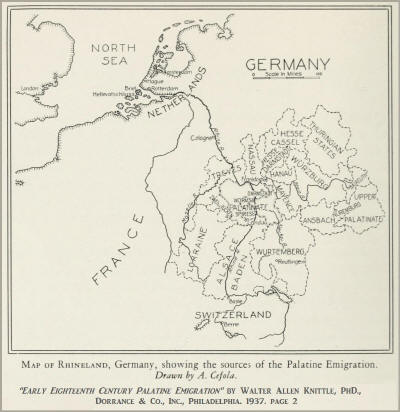 Part I is the outline D.J. presented
about his ancestry going
back to Christian White*, Jr. and Elizabeth Stonebraker*. Although D.J. stated his
great grandparents arrived in the new world after the Revolutionary War from
Germany, court and land records proved that Christian White Jr. who married
Elizabeth Stonebraker was actually born in the Pennsylvania colony as his
parents were already established in Lancaster with a
225 acre farm
at the
time of his birth.
Furthermore, there is no proof that Christian Wyse / White* Sr. was from Germany,
but the Lancaster area was settled predominantly by immigrants from
Germany, Switzerland and Ireland (Scotch-Irish). Christian White Jr.'s
parents,
maternal grandparents and great-grandparents were Palatine Mennonites** of Swiss origin and
migrated north to the Palatinate area of Germany for a time to escape
religious persecution before coming to the new world in September 1717
settling in the Pequea and Conestoga areas of Lancaster.**
The following is a recap of Christian and Elizabeth’s ancestry and details of their
forbearer’s migration from Germany to colonial America to finally settle in Old
Washington Co., Tennessee.
Part I is the outline D.J. presented
about his ancestry going
back to Christian White*, Jr. and Elizabeth Stonebraker*. Although D.J. stated his
great grandparents arrived in the new world after the Revolutionary War from
Germany, court and land records proved that Christian White Jr. who married
Elizabeth Stonebraker was actually born in the Pennsylvania colony as his
parents were already established in Lancaster with a
225 acre farm
at the
time of his birth.
Furthermore, there is no proof that Christian Wyse / White* Sr. was from Germany,
but the Lancaster area was settled predominantly by immigrants from
Germany, Switzerland and Ireland (Scotch-Irish). Christian White Jr.'s
parents,
maternal grandparents and great-grandparents were Palatine Mennonites** of Swiss origin and
migrated north to the Palatinate area of Germany for a time to escape
religious persecution before coming to the new world in September 1717
settling in the Pequea and Conestoga areas of Lancaster.**
The following is a recap of Christian and Elizabeth’s ancestry and details of their
forbearer’s migration from Germany to colonial America to finally settle in Old
Washington Co., Tennessee.
*NOTE: Records show multiple variations of
spellings of the following surnames: Kneussel, Kneissle, Kniseley,
Kniceley, Kneisley, Knusli, Neisle, Nussli, Nicely; Kauffman, Coffman; Mueller, Miller; Stonebraker, Stonebracher, Steinbraker; White, Wise,
Wyse, Weit; Wolegmot, Walgemuth, Wohlgemuth, Walgamoot, Wohlgemut,
Wolgamott, Wohlgemot, Volgamott, Wolgemuth, Wulgemuth.
**PALATINE MENNONITES: During
the early years of the eighteenth century, many German and Swiss emigrants
accepted William Penn's offer and took up lands in the rich limestone
valleys of the Pequea and Conestoga regions, which were part of Chester
Co., PA until 1729, when Lancaster Co. was organized. These
emigrants were Mennonites, followers of Menno Simon who was a contemporary
of Martin Luther. The Mennonites of Palatinate, Germany and
Switzerland led simple religious lives with peculiar manners of simplicity
of dress and had an aversion of baptismal at birth, taking oaths and
military service and thus was subjected to rigorous persecution and high
taxes in their native homes in Europe. They came to seek refuge from
persecution in the English Quaker province of PA with the initial
migration in 1709 settling in Lancaster. 1717 was the 2nd large wave
of Palatine
migration and Christian White/Wyse's ancestors came over at this time.
Christian White Jr. was born around 1746 in the Donegal Twp.*
(later Mt. Joy) of Lancaster, Pennsylvania and
was the son of Christian Wyse/White Sr. and Barbara Miller. The family
lived on a
225 acre farm
south of Conewago Creek next door to
Christian Sr.’s brother-in-law, Abraham Wohlgemuth* (he married
Barbara Miller-White’s sister, Elizabeth Miller).
SEE
PLATS Barbara and Elizabeth
Miller were the daughters of Michael Miller and Barbara Kneisley*
who lived in East Hempfield Twp. of Lancaster. As
of now, the parentage of Christian Wyse/White Sr. is unknown. There were
several White families who lived in the Mt. Joy area near Christian White
Sr. (see
Macro Map of Mt. Joy Twp.) to include Hugh White and his sons
William, Moses and Henry White who were Scotch-Irish but I do not think
they were related
to Christian “Wyse” White Sr. Jacob Shelly lived near these
White’s as well. Jacob Shelly married Mary Kneisley, the sister of Barbara
Kneisley (wife of Michael Miller) and owned several parcels in both Mt.
Joy and East Hempfield. “Wyse” was recorded on Christian Sr's. land
record, however, there are other records which showed “White” which put
into question his true surname. It was quite common to have variations of
spellings of
surnames at that time due to illiteracy, phonetic interpretation,
transcription errors and Anglicizing surnames of immigrants from Holland,
Switzerland and Germany etc. East Hempfield was settled predominantly
by Palatine Mennonites and the Mt. Joy / Donegal area was settled
primarily by the Scotch-Irish but there was a substantial number of
Mennonite farmers in this area. Although there is no proof to
date, from my research, I am inclined to believe Christian Wyse/White Sr. was
a Palatine Mennonite based on his marriage to a proven daughter of
Palatine Mennonite parents Michael Miller and Barbara Kneisley, the
date and location of his property living next door to other Palatine
immigrants that settled in the area, and the German language.
*NOTE: Donegal Twp., PA was named after
Donegal, Ireland and established in 1722; Mt. Joy Twp (or "Mountjoi") est. 1759
was formed out of Donegal and named after Viscount Mount Joy,
Historical Map of Lancaster
Co. and its Townships
PLATS - Wohlgemuths and Wyse/Whites - Mt. Joy Twp., PA
Survey Maps of Christian Wise / Wyse 225
Acres
MACRO MAP MT. JOY TWP.
http://www.phmc.state.pa.us/bah/dam/rg/di/r17-522WarranteeTwpMaps/r017Map2834LancasterMtJoyWeb.pdf
Christian White Jr.'s grandfather was Michael
Miller, born about 1689 in Switzerland or Germany. His parents are
unknown but I suspect he was a relative of Jacob
Mueller/Miller who came over to Pennsylvania in 1710 along with Martin Kendig,
Rev. Hans Herr and Christian Herr acquiring 10,000 acres on the Pequea
river in the Conestoga area of now Lancaster, PA to start a Mennonite community for the
Palatine pilgrims. About 1715 or 1716, Martin Kendig returned to
Europe to convince other Mennonite families to come to colonial
Pennsylvania and cultivate the fertile land of the Conestoga area.
In 1717, Martin Kendig & Co., with John Herr, obtained a
warrant for 5,000 acres on Mill Creek and Conestoga expanding the Pequea
settlement. Michael
Miller was one of the first Palatine Mennonites who acquired land from
Kendig & Co. 5,000 acre warrant and settled the area.
From the "Minute Book of the Board of
Property" dated February 8, 1717, it states:
"Agreed with Martin Kendig and Hans
Herr for 5000 acres of land to be taken in several parcels about Conestoga
and Pequea Creeks at 10 pounds currency to be paid at the returns of the
surveys and the usual quitrents, it being for settlements for several of
their countrymen that are lately arrived here. The Warrant for this
land is signed on September 22, 1717 to the following.... Michael Miller -
500 acres"*** pg. 157
***"THE
MENNONITE IMMIGRATION TO PENNSYLVANIA In the Eighteenth Century, Part
XXXIII of a Narrative and Critical History Prepared at the Request of The
Pennsylvania-German Society," by C. HENRY SMITH, Ph.D., Norristown,
Pa. 1929; Chapter IX pgs. 259-277
“1710 Pequea Settlement Tour Resource Information Booklet” by Samuel
E. Wenger, Mennonite Historical Society
Before 1727, the Palatine Immigration lacked colonial control with
documentation and registration upon entry. There were no manifest records
maintained by authorities, therefore we do not know the name of the ship Michael
Miller was on. However, it is highly probable that he, his wife (who
died in route) and son, Jacob,
were on board the same vessel as Antonius Kneisley (future father-in-law; see his section below)
and Andrew Kauffman (his future brother-in-law) based on several facts.
First, the timeline of when he acquired his land in 1717. One of his
parcels was purchased from Hans Herr and Martin Kendig, the founding
Mennonite leaders who paved the way for the Palatine Migration to
Lancaster. Second,
the location of the parcels being next door to Kauffman and Kneisley.
And third, marrying Barbara Kneisley, the daughter of Antonius Kneisley
and the sister of Andrew Kauffman's wife, Elizabeth. Barbara
Kneisley's grandmother was Elisabeth Mueller (died in Alsace) and Michael
Miller could
possibly be related to her as well. The
Millers, Kauffmans and Kneisleys were on board one of the 3 vessels which arrived in
Philadelphia on September 8, 1717, under the commands of Captain Richards
(164 passengers arrived); Captain Tower (91 passengers arrived); and
Captain Eyers (108 passenger arrived) respectively totaling "363
Palatines”** The discrepancy in the number of passengers for each
vessel was due to the deaths of the travelers which their bodies were
disposed out to sea before arriving in Philadelphia. This was to
curtail the spread of disease due to cramped conditions. The
trans-Atlantic journey was
very hard, unpredictable and the chances of survival were fair at best.
SEE HARDSHIP AND
STORIES OF TRANS-ATLANTIC PASSAGE
**
https://archive.org/stream/pennsylvaniagerm03penn_2/pennsylvaniagerm03penn_2_djvu.txt
"Andrew Kauffman married twice.
His last wife, Elizabeth Kneissle
(the sister of Michael Miller's 2nd wife),
died about 1759. He came from Friesenheim, in Oberant of Neustadt,
Palatinate, where he is recorded as a Mennonite in 1716. Presumable
he is Andreas Kaufman, the "Hosenstriker" or trouser-knitter mentioned at
Streffisburg, Switzerland. He left Rotterdam, Holland in the early
part of June, 1717, and arrived in Philadelphia in September and located
on 200 acres of land adjoining Isaac Kauffman on the west. This was
part of the 5000 acre blanket warrant granted to Hans Herr and Martin
Kendig on September 27, 1717. This 200 acre tract was surveyed
Saturday, May 31, 1718. On the same day John Witmer's 200 acres
which adjoined Andrew Kauffman on the west and Michael Miller's 300 acres
on the north were surveyed."
SOURCE: "A Genealogy and History of
the Kauffman-Coffman families of North America”, by Charles Fahs Kauffman;
Mennonite Publishing House, Scottsdale, Pennsylvania, 1940; page. 1.
https://babel.hathitrust.org/cgi/pt?id=wu.89066176967;view=1up;seq=1
More on Andrew Kauffman:
http://www-personal.umich.edu/~bobwolfe/gen/pn/p11072.htm
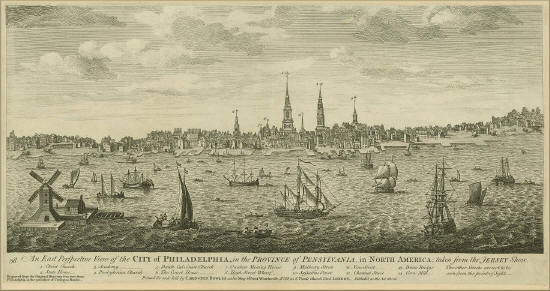 Michael Miller arrived in
colonial Pennsylvania on September
8, 1717, with his son Jacob. His first wife (unknown) most likely died
on the long hard journey across the Atlantic which took 3 months. In
June 1717, the ship left the port of Rotterdam to London to receive its
sponsorship (only British ships were permitted entry
to the colonies), then onward to the port Philadelphia. Upon
arrival, Michael Miller and other fellow Mennonites met up with their
sponsor who escorted them out to the Pequea settlement of the
Conestoga area. At this time there were two passages available for a
traveler to reach the Lancaster area. The first route was established in
1646 by fur trappers which started from New Castle, Delaware, crossing
over the Octorara Creek to the Susquehanna River and then paralleled the
Susquehanna northward. The other road began from Philadelphia,
established in 1687, and over time, the 75 mile passage was completed all
the way to the Susquehanna river by 1712. Roads were the lifeblood
for community survival and development. Although we can not be for certain which
road Michael Miller, Antonius Kneisley (future father-in-law) and Andrew
Kauffman (future brother-in-law) traveled on to reach the Pequea
settlement, (which would also dictate which port they were dropped off), I
am inclined to believe they landed at the port of Philadelphia and took
the Great Conestoga Road.
Michael Miller arrived in
colonial Pennsylvania on September
8, 1717, with his son Jacob. His first wife (unknown) most likely died
on the long hard journey across the Atlantic which took 3 months. In
June 1717, the ship left the port of Rotterdam to London to receive its
sponsorship (only British ships were permitted entry
to the colonies), then onward to the port Philadelphia. Upon
arrival, Michael Miller and other fellow Mennonites met up with their
sponsor who escorted them out to the Pequea settlement of the
Conestoga area. At this time there were two passages available for a
traveler to reach the Lancaster area. The first route was established in
1646 by fur trappers which started from New Castle, Delaware, crossing
over the Octorara Creek to the Susquehanna River and then paralleled the
Susquehanna northward. The other road began from Philadelphia,
established in 1687, and over time, the 75 mile passage was completed all
the way to the Susquehanna river by 1712. Roads were the lifeblood
for community survival and development. Although we can not be for certain which
road Michael Miller, Antonius Kneisley (future father-in-law) and Andrew
Kauffman (future brother-in-law) traveled on to reach the Pequea
settlement, (which would also dictate which port they were dropped off), I
am inclined to believe they landed at the port of Philadelphia and took
the Great Conestoga Road.
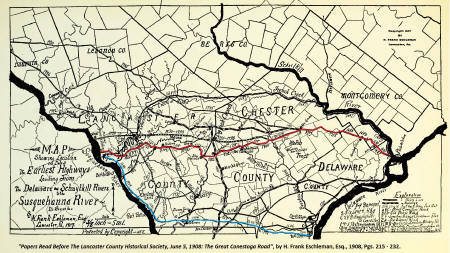 * NOTE: The
adjacent map is from H. Frank Eshleman, Esq., who explained in his
research the timeline of the development of the Great Conestoga Road (or
Kings Highwy) and by 1714, was opened all the way to the Susquehanna
River, 75 miles west from Philadelphia, which was a shorter route than the
traditional route from New Castle, DE. This road had its beginnings in Philadelphia in
1687 and through the years, was extended and developed.
"Papers Read Before The Lancaster County Historical Society, June 5, 1908:
The Great Conestoga Road", by H. Frank Eschleman, Esq., 1908, Pgs.
215 - 232. On a Palatinate German draft of Mennonite leaders, Martin
Kendig and Hans Herr, the
road was marked as early as 1710 (MAP) and the Conestoga Road passed
within yards of the site where Hans Herr's house stood. After 1741
the Kings Highway was known as the Lancaster Road or the Great Road and became the most
traveled road of its time.
"Early Roads in Chester County",
April 1986 Vol. 24, No. 2, Pgs. 59–66.
* NOTE: The
adjacent map is from H. Frank Eshleman, Esq., who explained in his
research the timeline of the development of the Great Conestoga Road (or
Kings Highwy) and by 1714, was opened all the way to the Susquehanna
River, 75 miles west from Philadelphia, which was a shorter route than the
traditional route from New Castle, DE. This road had its beginnings in Philadelphia in
1687 and through the years, was extended and developed.
"Papers Read Before The Lancaster County Historical Society, June 5, 1908:
The Great Conestoga Road", by H. Frank Eschleman, Esq., 1908, Pgs.
215 - 232. On a Palatinate German draft of Mennonite leaders, Martin
Kendig and Hans Herr, the
road was marked as early as 1710 (MAP) and the Conestoga Road passed
within yards of the site where Hans Herr's house stood. After 1741
the Kings Highway was known as the Lancaster Road or the Great Road and became the most
traveled road of its time.
"Early Roads in Chester County",
April 1986 Vol. 24, No. 2, Pgs. 59–66.
In 1717, the Conestoga tribe (after which the town was named) was
still living in these parts on the Susquehanna river and the Quaker and
Mennonite settlers got along very well with their Native American
neighbors unlike the Scotch-Irish settlers of Donegal Twp. who who were a
bit uneasy of the foreign ways of the indigenous people. It's
important to point this out because since the beginning of colonial rule,
there had much strife, war and death between the white settlers and native
tribes. Records showed that Conestoga tribe highly regarded and
trusted William Penn. In 1711, the chiefs stated to the colonial counsel
that
"As to the Palatines, they are safely seated.".**
Mennonite
children even played with the native children.* Michael Miller acquired two parcels of land
in East Hempfield Twp. of Lancaster Co. PA. via warrants with 6 acres on
each hundred acres allowance for roads. The cost of each acre was 10 pence
of Pennsylvania currency.*** His first parcel was warranted on July 27,
1717, for 200 acres northeast of Andreas Kauffman’s land. His second
parcel of 269 acres, was warranted on November 22, 1717, and purchased
from Herr and Kundig’s 5,000 acre blanket warrant. This parcel was east
and south of Antonius (Andrew) Kneisley's land, issued under his son's name
"Johannes “Hans” Kneisley, Sr., and later sold to Daniel Ashleman and
patented under that name.
Miller's Land
PLATS - 2 Parcels of Michael Miller
*NOTE: According to an article published
in the
"Hazards PA Register, Vol. 7, No. II March 12, 1831, pg. 163, a
descendant of Mennonite Rev. Melchior Brenneman (1665-1732), explained how
the Mennonite and Native American children would play together which
demonstrated great trust among them. It further explained that the
reason the Palatines got along so well with the tribe was that they did
not provide alcohol nor trade with them for their religion forbade it.
**SOURCE: "Lancaster County
Indians: Annals of the Susquehannocks and Other Indian Tribes of the
Susquehanna" by Eshleman, H. Frank, 1908, pg. 201
*** According to Andreas Kauffman's Land
Patent (Michael Miller's brother-in-law and neighbor) he paid 20 pounds
for 200 acres.
MAP HEMPFIELD TWP:
http://www.phmc.state.pa.us/bah/dam/rg/di/r17-522WarranteeTwpMaps/r017Map2822LancasterEastHempfieldWeb.pdf
There is a discrepancy whether his
first parcel was 200 or 300 acres between the two sources offered.
Being neighbors, Michael Miller (age 27)
came to know Barbara Kneisley (d/o
Antonius and Magdalena Kneisley
- see their section below) and
about 1720, they married in Lancaster and had 7 children together born
between 1720-1730. Michael and Barbara raised 8 children
(including Jacob from his first wife). D.J.'s ancestry came through their
daughter, Barbara Miller, who married 1st, Christian White/Wyse Sr. Michael
Miller
wrote his Will on March 23, 1737, naming his wife, Barbara, as the administratrix. Three years later, Michael died in 1739 and the Will
was proven in court on August 20, 1739. Barbara Miller and Frederick
L. Wolslegel were named in the Inventory of the Estate of Michael Miller
dated March 21, 1742. We know that Barbara was still a widow in 1749
when Moravian Missionary, George Hantsch, from Bethlehem, PA, visited the
Mennonites of Lancaster and her name was written in his diary as follows:
"In Conestoga and around Lancaster ...#5 Mrs. Michael Miller, widow."*
Therefore, sometime after 1749, Barbara Kneisley-Miller married Frederick Wolslegel but
they did not have any children together.
*SOURCE: "Brother
Hantsch Visits the Mennonites, A Moravian Missionary Diary of 1748",
The Pennsylvania Dutchman, Nov. 1, 1951, pgs. 1 and 5.
MORE INFO ON MICHAEL MILLER:
"Barnard Miller and Allied Families, The Miller Family or Michael
Miller and his Descendants", By Kenneth Duane Miller, Des Plains
Publishing Co., 1952, pgs. 141 - 160
According to a land record dated May
16, 1758 (proven January 16, 1764), Lancaster, Pennsylvania Deed Book K76,
it outlines the children of Barbara Kneisley and Michael Miller:
"Barbara Wolslegle, widow of Michael
Miller of Hempfield Twp., Lancaster county, deceased and the other heirs
of Michael Miller, deceased are named. His issue included:
Michael, Jacob, Christian, David, Samuel the sons; Elizabeth, wife of
Abraham Willgamwood (Wohlgemuth),
Barbara, wife of Samuel Willgamwood
(Wohlgemuth),
Maudlin, wife of Peter Bawsler, the
daughters. (Note: Heinrich
Wohlgemuth, brother of Abraham, was also mentioned in K-76 deed.)
Barbara outlived her second husband
as Frederick died on June 1, 1772, intestate. Adam and Anna Sheller
were granted letters of administration for Frederick's Estate.
Barbara wrote her Will on April 1, 1771, with several codicils added.
She died in 1777 and the Will was proven in court on February 21, 1777. The burials of Michael Miller and Barbara Kneisley are unknown but
probably in the vicinity of their old property in East Hempfield Twp.
Based
on the Will of Barbara Kneisley-Miller-Wolslegel, it
was
evident she was not pleased with
daughter, Barbara Miller-White-Wohlgemuth, and son-in-law, Samuel
Wohlgemuth's,
decision to sell their share of land in Mt. Joy to move south to Hagerstown,
Maryland. Thus in 1777, she only
bequeathed them one shilling.
WILLS - Michael Miller and Barbara
Kneisley
WILL of Michael Miller
SOURCE:
More info on Michael Miller and descendants by Jeffrey E. Mason.
Includes references and footnotes of records.
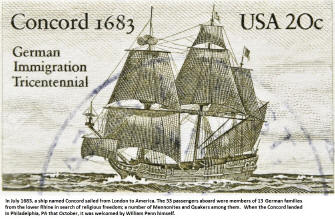 D.J.
White's 3G grandmother, Barbara Kneisley-Miller, was the daughter of Antonius Kristopher Kneisley/Knussli and Magdalena Hempstead,
and was born in the Alsace
Province of Germany. She was listed in the 1707 census in Alsace,
age 4, and living with her parents and siblings. Antonius and Magdalena were from
Eggiwil, a town in the Bern Canton of Switzerland. They left the
area along with many other Anabaptist / Mennonites due to religious
persecution by the Church of Switzerland, primarily because of its
adverse position on taking oaths, holding office, participating in war which were
against God, and the dogma on
adult baptism. Anabaptist Mennonites held a strong belief that
baptism was only performed on those old enough to understand
accepting Christ as the Savior and to join the church. The Knussli
clan settled in the Alsace area for a time, but the same persecution
erupted forcing the family to migrate northward on the Rhine river to the
lowlands of the Netherlands, a place known for its religious tolerance and also a major port to consider leaving
mainland Europe. Antonius and family (his parents, Hans Knuslli and Elisabeth Mueller
died in Alsace) headed for
Rotterdam, at which place they boarded a ship bound for Philadelphia by
way of England. On September 8, 1717, Antonius, Magdalena and
children survived the arduous voyage
and met their sponsor, Martin Kendig, who took them,
along with several hundred other Mennonite pilgrims (including Michael
Miller as explained earlier), to the Pequea settlement in Conestoga (now
Lancaster Co., PA) to start a new life. The payment for the
1717 journey was arranged by Dutch Mennonite leaders in Amsterdam who worked through
William Penn and King George I of England, that the
Palatine pilgrims were excellent farmers and skilled craftsmen that would improve
the open frontier in Pennsylvania. They were a resourceful peaceful people
that would make compliant residents to the Crown.
D.J.
White's 3G grandmother, Barbara Kneisley-Miller, was the daughter of Antonius Kristopher Kneisley/Knussli and Magdalena Hempstead,
and was born in the Alsace
Province of Germany. She was listed in the 1707 census in Alsace,
age 4, and living with her parents and siblings. Antonius and Magdalena were from
Eggiwil, a town in the Bern Canton of Switzerland. They left the
area along with many other Anabaptist / Mennonites due to religious
persecution by the Church of Switzerland, primarily because of its
adverse position on taking oaths, holding office, participating in war which were
against God, and the dogma on
adult baptism. Anabaptist Mennonites held a strong belief that
baptism was only performed on those old enough to understand
accepting Christ as the Savior and to join the church. The Knussli
clan settled in the Alsace area for a time, but the same persecution
erupted forcing the family to migrate northward on the Rhine river to the
lowlands of the Netherlands, a place known for its religious tolerance and also a major port to consider leaving
mainland Europe. Antonius and family (his parents, Hans Knuslli and Elisabeth Mueller
died in Alsace) headed for
Rotterdam, at which place they boarded a ship bound for Philadelphia by
way of England. On September 8, 1717, Antonius, Magdalena and
children survived the arduous voyage
and met their sponsor, Martin Kendig, who took them,
along with several hundred other Mennonite pilgrims (including Michael
Miller as explained earlier), to the Pequea settlement in Conestoga (now
Lancaster Co., PA) to start a new life. The payment for the
1717 journey was arranged by Dutch Mennonite leaders in Amsterdam who worked through
William Penn and King George I of England, that the
Palatine pilgrims were excellent farmers and skilled craftsmen that would improve
the open frontier in Pennsylvania. They were a resourceful peaceful people
that would make compliant residents to the Crown.
"In the spring of 1717, some 300 Palatine Mennonites were in
Rotterdam to embark for Pennsylvania and they received financial support
from the Dutch Mennonites."
According to the Amsterdam archives, undated but
assumed 1717, King George I of England through his agent, Johan Rudolph Ochs, declared the following invitation:
"Since we have been informed that the Christians called Baptists or
Menonists have been denied freedom of conscience in various parts of
Germany and Switzerland, and endure much opposition from their enemies so
that they can support themselves only with difficulty, and must live
scattered about here and there, and have been hindered in the public
worship, it is made known to them by this that all those who desire may
enjoy freedom on conscience and may worship according to their conscience
in a land in American bordering Pennsylvania and Virginia under the
jurisdiction of the government of the King of England."
SOURCE: "Mennonite Emigration to
Pennsylvania" by de Hoop Scheffer, translated by S. W. Pennypacker, in
Pennsylvania Magazine of History, Vol II., pg 127.
"William Penn's familiarity with
Holland and her people opened a new asylum for these Swiss Refugees.
The Mennonite and Quaker are very similar in belief so that learning of
each other's needs, Pennsylvania was the most natural center of gravity of
land and freedom of conscience could be had for the taking. Penn
made several trips up the Rhine Valley promoting the settlement of
Pennsylvania. Rupps "30,000 Immigrants" shows how opportune Penn's offer
was considered. By 1730, the tide of immigration was large enough to
make the British speaking subjects lose sleep about the "German Peril."
SOURCE: "A Genealogy and History of
the Kauffman-Coffman families of North America”, by Charles Fahs Kauffman;
Mennonite Publishing House, Scottsdale, Pennsylvania, 1940; page xi.
https://babel.hathitrust.org/cgi/pt?id=wu.89066176967;view=1up;seq=1
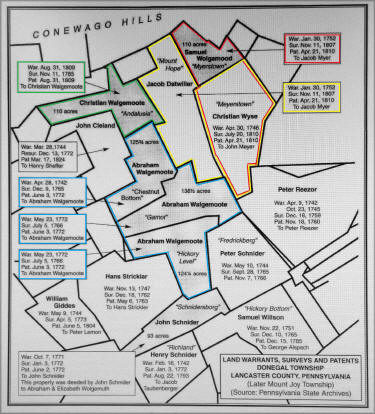 D.J. White's great great grandparents were Christian Wyse/White Sr. and Barbara Miller.
It's not clear how they met since
Christian lived in Donegal Twp.* and Barbara was a Mennonite from
nearby East Hempfield Twp. Mennonites were a tight closed community who stayed to themselves
and parents would arrange marriages of their children within the faith. I suspect
their acquaintance was through the church affiliation, as well as the
Wohlgemuth connection, since
Barbara's older sister,
Elizabeth, was already married to Palatine emigrant Abraham Wohlgemuth* and established their
387 acre farm in Donegal Twp. next door to
Christian Sr's. Hence, Christian Sr. and Abraham were
most likely Mennonites. There is no marriage record found for
Barbara and Christian, but based on the initial land entry of when he
acquired his first parcel of land situated next to Abraham's, I am placing their
marriage sometime before March 1737.
D.J. White's great great grandparents were Christian Wyse/White Sr. and Barbara Miller.
It's not clear how they met since
Christian lived in Donegal Twp.* and Barbara was a Mennonite from
nearby East Hempfield Twp. Mennonites were a tight closed community who stayed to themselves
and parents would arrange marriages of their children within the faith. I suspect
their acquaintance was through the church affiliation, as well as the
Wohlgemuth connection, since
Barbara's older sister,
Elizabeth, was already married to Palatine emigrant Abraham Wohlgemuth* and established their
387 acre farm in Donegal Twp. next door to
Christian Sr's. Hence, Christian Sr. and Abraham were
most likely Mennonites. There is no marriage record found for
Barbara and Christian, but based on the initial land entry of when he
acquired his first parcel of land situated next to Abraham's, I am placing their
marriage sometime before March 1737.
*Abraham Wohlgemuth (b. 1714 - d. March 7,
1786) married Elizabeth Miller and was the brother-in-law to Christian
Wyse/White Sr. He was Christian's neighbor and friend. Abraham
and Elizabeth owned 3 parcels of land totaling 361.5 acres each having a
land patent name: "Hictory Level", "Chestnut Bottom", "Gamot" of Mt. Joy
Twp., Lancaster, PA. Their home was built on Chestnut Bottom and are
presumed to be buried at their homestead in unmarked graves. Their 6 children were: Henry, Christian,
Abraham, Mary, Barbara and Salome. For more info on his line, see
"Hickory Level and Chestnut Bottom; the family of Abraham Wohlgemuth and
Elizabeth Miller of Lancaster County, Pennsylvania" 1999, by Gerald
Faus Wolgemuth and Ruth Bryan.
"To Christian Wyse, 100 acres adjacent Jacob Dotwiller in Donegal
Twp., Lancaster Co. to commence 1 March 1737, he to pay 15 pounds 10
shillings current money of the province with lawful interest and yearly
quit rent of 1/2 penny sterling for every acre, warranted in Philadelphia
30 April 1746."
SOURCE: Pennsylvania State Archives, RG
17, Records of the Bureau of Land Records; Applications 1741-1746.
This was the first of many land entries Christian Wyse/White made since
upon his death, he
owned 225 acres adjacent to Jacob Dotweiller.
*Mt.
Joy Twp was established in 1759 out of Donegal Twp.
Barbara
and Christian's marriage lasted about 10 years and around 1747, he died
shortly after the birth of Christian Jr. He left no Will* which leads me to
believe it was a sudden unexpected death. Barbara and the three children,
Barbara, Magdalena, and Christian Jr. were left alone with a
225 acre farm. Her sister,
Elizabeth, lived
next door and helped with the children. In October 1747,
Barbara Miller-White and her brother-in-law, Abraham Wohlgemuth, were the
administrators of the Estate of Christian Wise/White Sr. On October 9,
1747, they requested John Leman and Jacob Taylor to appraise the value of the
property. There was an administration bond dated October 14, 1747,
stating: "We Barbara
White and Abraham Wolgamot and Peter Reyarall
[neighbor Peter Reizer / Reezer]
of the county of Lancaster,
province of PA, are bound to Wm. Plumsted, Esq. Register General of
the Province of PA."
*SOURCE: In the Lancaster Co., PA
Orphans Book 1742-1760, there is a record which shows that Christian White
died intestate 1747. Peter Reezer was Christian Wyse/White' neighbor
living at the southern end of Christian's property who acquire his 100
acre parcel a few years earlier on April 9, 1742.
As administrators of Christian's Estate, the court
ordered them to make "perfect inventory" to exhibit at the Register
Office at Lancaster by November 14, 1747. On January 28, 1750, a
document entitled "Administration Amount for Christian White, Decd" stated: "Barbara Wolgomot, wife of
Samuel Wolgomot (formerly Barbara White widow) and Abraham Wolgomot,
administrators of Christian White deceased placing a value on the
Christian White inventory of 122 pounds O.S. 6D."
Let's take pause to talk about the Wohlgemuths
since they were closely tied with the Millers, Whites, and Stonebrakers.
Three “Wohlgemuth” brothers, Heinrich (age 24), Abraham (age 22) and Joseph (age 20),
were from Germany and emigrated to colonial Pennsylvania on September 1, 1736.
They left the port of Rotterdam, Netherlands in June 1736, stopped in Cowes,
England on the British ship "Harle",
then sailed onward to Philadelphia.
"SHIP HARLE: Rotterdam, Netherlands via Cowes, England to Philadelphia on 1
September 1736
District of Philadelphia - Port of Philadelphia. Ship:
Harle, of London. Master Ralph Harle arrived at the Court- house in
Philadelphia on 1 Sept. 1736, with one hundred fifty one foreigners from
the Palatinate and other places, who, with their families, making in all
three hundred eighty-eight persons were imported here and qualified"
SOURCE:
https://www.immigrantships.net/v4/1700v4/harle17360901.html
The founder of
Hagerstown, Jonathan Hager, was also on this ship and became acquainted
with the Wohlgemuth brothers. Heinrich live in Mt. Joy area of
Lancaster, Pennyslvania first then moved across the Susquehanna to York
Co.; Abraham settled
in Mt. Joy and married Elizabeth Miller as explained
previously; and Joseph
settled in Frederick (now Washington Co.) Maryland acquiring 520 acres on the bank of Conococheague Creek,
outside of Hagerstown where he
built a
grist mill which
is still standing today. Samuel Wohlgemuth, who married Barbara
Miller-White, is a relative of the three brothers and he arrived 6 years
later in 1742 on the ship
"Francis & Elizabeth".
SOURCE: “Names of Foreigners who Took the
Oath of Allegiance to the Province and State of Pennsylvania 1727 – 1775.”
By William Henry Engle, M.D., Harrisburg: Edwin K. Meyers State Printer
1892.
“A collection of thirty thousand names of
German, Swiss, Dutch, French, Portuguese and other immigrants in
Pennsylvania", Rupp, Israel Daniel, 1803-1878. YA Pamphlet
Collection (Library of Congress) Online Book
https://archive.org/details/collectionofthir00rupp
Palatine Ships Harle and Francis and
Elizabeth - pg. 328
https://archive.org/stream/pennsylvaniagerm03penn_2#page/n5/mode/2up
Barbara remarried to Samuel
Wohlgemuth about 1749 in Lancaster, PA. Samuel was noted on
the Donegal Twp. tax rosters of 1750 and 1751. In addition to
raising Christian Jr., Barbara and Magdalena, Samuel and Barbara had 4 children
together: John, Mary, Esther and Franny. Samuel was an important
role model for Christian because he was the only "father" Christian
knew as his blood father died when he was an infant. There is no marriage record found, but
Barbara Miller-White was named a "Wolgomot"
in the aforementioned document in January 1750. Samuel was a
Palatine Mennonite emigrant and a relative of next door neighbor, Abraham
Wohlgemuth. Samuel was born about 1724 and came over on the
"Francis &
Elizabeth"
arriving in Philadelphia on September 21, 1742. Upon his arrival,
hel most likely went to live with Abraham and Elizabeth and worked on
their farm up until he married widow Barbara. This would explain how
become acquainted with Christian and Barbara and thus was brought into the
family.
"Ship Francis & Elizabeth
Captain George North, 1742 Left the port of Rotterdam by way of
Deal, England
[NOTE: List C – 94 people; the first 92
names of C list are missing on this list.]
328 Pennsylvania German Pioneers
No. 149 (# men)
74 1/2 ( # women and children)
223 1/2 Total
“At the Courthouse Philadelphia, Sept. 21st, 1742. Present: William
Till & Robert Strettel, Esq. The Foreigners whose names are underwritten,
imported in the Ship Francis & Elizabeth, George North, Master, from
Roterdam, but last from Deal, did this day take the usual Qualifications
to the Government, viz.,”
“SAMUEL ( O ) WHOLGEMUTH”
SOURCE: "Pennsylvania German Pioneers,
A Publication of the Original Lists of Arrivals In the Port of
Philadelphia" by Ralph Beaver Strassburger, Edited by William John
Hinke, Volume I, Pages 327 - 330, Published by Genealogical Publishing Co.
Note: "O" indicates that Samuel Wohlgemot, was unable to read or write and thus made his mark when he took
the Oath of Abjuration at arrival in Philadelphia. Samuel was born about 1724 (no birth record
found) based on being noted as an adult on List C the when he took the
oath in 1742. He most likely born in the Palatine area of Germany
and a cousin of Abraham Wohlgemuth.
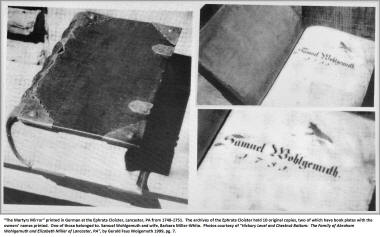 In 1751, Samuel and Barbara
purchased a
copy of The Martyrs Mirror** printed in German by the
Ephrata Cloister. The
Cloister (22 miles east of Mt. Joy/Donegal) was established in 1732 by German Pietist mystic,
Conrad Beissel. According to Gerald Faus Wolgemuth's
"Hickory Level and Chestnut Bottom"*, he stated that the oldest
surviving artifact of the early Wohlgemuths belonged to Samuel. The
Ephrata Cloister holds 10 original copies and two have bookplates, one of
which is "Samuel Wohlgemuth ~ 1751". We know that Samuel was illiterate upon
arrival at Philadelphia in 1742 as he could not sign his name, but
apparently he learned how to read to desire to pay for a copy of this
1,500 page book revered by Mennonites which still serves today as a complimentary
guide to the Bible. This is additional proof that German was the
preferred language in the household and that Christian Jr. and his
siblings were most likely taught German and brought up in the Mennonite
faith while living in Pennsylvania.
In 1751, Samuel and Barbara
purchased a
copy of The Martyrs Mirror** printed in German by the
Ephrata Cloister. The
Cloister (22 miles east of Mt. Joy/Donegal) was established in 1732 by German Pietist mystic,
Conrad Beissel. According to Gerald Faus Wolgemuth's
"Hickory Level and Chestnut Bottom"*, he stated that the oldest
surviving artifact of the early Wohlgemuths belonged to Samuel. The
Ephrata Cloister holds 10 original copies and two have bookplates, one of
which is "Samuel Wohlgemuth ~ 1751". We know that Samuel was illiterate upon
arrival at Philadelphia in 1742 as he could not sign his name, but
apparently he learned how to read to desire to pay for a copy of this
1,500 page book revered by Mennonites which still serves today as a complimentary
guide to the Bible. This is additional proof that German was the
preferred language in the household and that Christian Jr. and his
siblings were most likely taught German and brought up in the Mennonite
faith while living in Pennsylvania.
*SOURCE: "Hickory Level and
Chestnut Bottom: The Family of Abraham Wohlgemuth and Elizabeth
Miller of Lancaster, PA", by Gerald Faus Wolgemuth 1999, pgs.
7-8. **The Martyrs Mirror was first published in 1660 in the
Netherlands and tells the stories of Christian martyrs, especially those
who were Anabaptists. Author Thieleman Jansz
van Braght was an elder of the Flemish Mennonite congregation at Dordrecht. The 1,500 page book includes
311 illustrations of
Martyrs by engraver Jan Luiken. It took 15 monks and 3 years
(1748-1751) to translate from Dutch to German and print 1,300 copies at
the Ephrata Cloister. The book weighed 13 lbs. It became the
largest book printed in America before 1800. Samuel Wohlgemuth was
one of those buyers who requested his name to be printed on the book
plate. "The Martyrs Mirror" is deemed the
most important book next to the Bible among the Amish and Mennonites.
The full title: "The Bloody Theater or Martyrs Mirror of the Defenseless
Christians who baptized only upon confession of faith, and who suffered
and died for the testimony of Jesus, their Saviour, from the time of
Christ to the year A.D. 1660."
https://mla.bethelks.edu/holdings/scans/martyrsmirror/
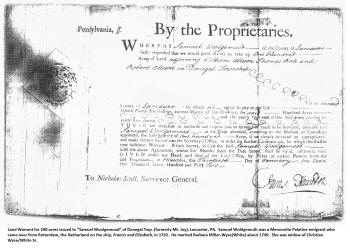 Samuel
Wohlgemuth's 75 acre parcel was situated adjacent to "Christian
Wyse Sr's" (deceased) 225 parcel and warranted to him on January 30, 1752.
The warrant showed
"Samuel Woolgamood granted 100 acres of land
adjoining William Allison, Thomas Bole and Robert Allison in Donegal Twp.
..... agreed to pay 15 pounds, 10 shillings current money for the said 100
acres and a year quit rent of one half penny sterling for every acre." The 15 acre difference was most likely due to a
survey which validated the true acreage of 75 and thus would reduce his
taxes. Samuel was already married to Barbara at this time expanding the
former White/Wyse property to a total of 300 acres which was next door to
Abraham's.
Samuel
Wohlgemuth's 75 acre parcel was situated adjacent to "Christian
Wyse Sr's" (deceased) 225 parcel and warranted to him on January 30, 1752.
The warrant showed
"Samuel Woolgamood granted 100 acres of land
adjoining William Allison, Thomas Bole and Robert Allison in Donegal Twp.
..... agreed to pay 15 pounds, 10 shillings current money for the said 100
acres and a year quit rent of one half penny sterling for every acre." The 15 acre difference was most likely due to a
survey which validated the true acreage of 75 and thus would reduce his
taxes. Samuel was already married to Barbara at this time expanding the
former White/Wyse property to a total of 300 acres which was next door to
Abraham's.
On June 7, 1758,
Abraham "Wolgamet" prayed to the court to make an order empowering the
administrators to sell a piece of Christian White's deceased land, to enable
the administrators (Barbara and Abraham) to bring up and maintain the
children. On June 19, 1758, the Lancaster Orphan Court approved the sale of a 100 acre parcel of
the estate of Christian Wise /White at public vendue.
SOURCE: Lancaster Co., PA
Orphans Book 1742-1760 record shows Christian White died intestate 1747.
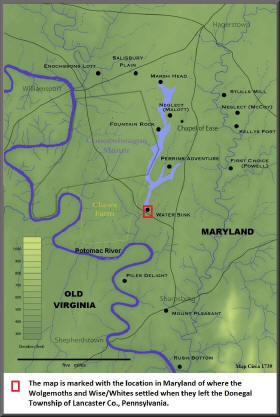 In 1761,
Samuel and Barbara (Miller-White) Wohlgemuth family left Lancaster, Pennsylvania
(which displeased Barbara's mother greatly) and migrated down
to the Hagerstown area of then Frederick Co., Maryland. They purchased 367 acres
in the marsh lands of the Leitersburg District for 600 pounds of
Pennsylvania currency from Joseph Tomlinson, the original land patent owner
of "Water Sink".
In 1761,
Samuel and Barbara (Miller-White) Wohlgemuth family left Lancaster, Pennsylvania
(which displeased Barbara's mother greatly) and migrated down
to the Hagerstown area of then Frederick Co., Maryland. They purchased 367 acres
in the marsh lands of the Leitersburg District for 600 pounds of
Pennsylvania currency from Joseph Tomlinson, the original land patent owner
of "Water Sink".
"Joseph Tomlinson Sr. Deeded To Samuel Vulgamet Sr. For 600 pounds
of Pennsylvania currency, Re-survey Of Water Sink Containing 367 Acres.
Witnesses: Moses Chaplins And Thomas Prather ~~
Rebecca Released Her Dower"
SOURCE: Book G, Pg 359 Frederick Co
Maryland 4 Sept 1761 - 5 Jan 1762
Samuel's relative, Joseph "Volgamot",
was already established in this area for some time owning several parcels of
land and a mill on the Conococheague River 2 miles upstream from the confluence of the Potomac and Conococheague Rivers
at
Williamsport. The mill still stands
today known as
"Kemp's Mill." This explains why Samuel and Barbara chose to move
south to Maryland and establish their mill at Water Sink not far from
Joseph's. In
an article, "The Hundreds of Washington County," by Jeffrey A. Wyand
[pgs. 302 - 306], it describes the boundaries of
"Marsh Hundred" named for the large savannah area to include Water Sink.
"Running from the mouth of the Antietam to the mouth of the Conococheague [creeks] and up that to "Vulgamot's"
Mill and from thence with the road that leads from Volgamots to Stulls."
Christian White Jr. was about 15 years old when he
moved down to Water Sink, Maryland* with his mother, stepfather, sisters and
family.
Christian Jr. and his half brother, John Wohlgemot, learned the trade of
operating a grist mill grinding corn, wheat, rye and other harvest
for food. By 1770, this area became the breadbasket of the nation
with its founding roots in milling starting in 1730s. Parts of
Samuel Wohlgemuth's original mill, established in 1769, still stand today
and is called
"Marsh Mills".
Photos of Samuel Wohlgemuth'S Grist Mill
*NOTE: Water Sink, Maryland is now known as The
Marsh Mills Historic District and part of the National Register of
Historic Places with the National Park Service. The 1783 Washington
Co., Maryland Supply Tax
assessed Samuel "Wolgamott" for a mill valued at £400 currency.
A 1780 agreement between Samuel and his son, John, indicated that they
owned a saw, grist and still mills on the Water Sink property. In 1811, John "Wolgamore"
(his son) sold 157 and 3/4 acres of land and Wolgamore’s Mill to Henry
Coffman. Records show that the mill was situated 8 miles from
Hagerstown. Over the years, the mill on Spielman Road has been known as
Wolgamore’s Mill, Marsh Mills, Haley’s Mill, Spielman's Mill. In
1888, the Mill was turned into a creamery altering the structure from
grain to dairy.
http://washingtoncountyhistoricaltrust.org/78-marsh-mill-circa-1850-east-of-willamsport-md/
https://mht.maryland.gov/secure/medusa/PDF/Washington/WA-II-130.pdf
On February 13, 1769, there was a boundary
dispute between Samuel "Volgamot" and his neighbor and wife's
cousin, Christian Ebersole /
Eversole, which required the land to be re-surveyed and depositions taken and
brought before the court at the March session in 1769.
Boundary Dispute - Samuel "Volgamot" and
Christian "Ebersole"
On July 22, 1768, Samuel "Wolgemuth" signed a bond in the amount
of 500 British pounds to Christian "Wise" Jr. and his 2 sisters
regarding their father's estate. This bond was their protection as
duly heirs to their father's estate in the event they were not named in
Samuel Wohlgemuth's will (which ended up happening anyhow 21 years later).
The timing of drawing up this document makes me think that mother,
Barbara, was sick or perhaps dying and was thinking ahead about ensuring
the future of her children's legacy with Christian White/Wyse Sr. after
she is gone. It also proved that all three of her children with
Christian Sr. moved down to Maryland from Pennsylvania. The bond was
recorded on August 17, 1768, in Frederick Co., Maryland at the request of
Christian "Wise" stating:
"Wherein Samuel Wolgemuth of Frederick Co., Maryland binds himself
to Christian Wise, Barbara Wise, and Magdalena Wise, all of Frederick Co.,
Maryland in the sum of 500 pound British sterling to pay the three above
named. They by their father, Christian Wise of Lancaster Co., PA,
deceased, were left a legacy. Some years ago, Christian, Barbara and Magdalena Wise left their legacy in the hands of Samuel Wolgamoth." --signed by Samuel Wohlegmutz, witnessed by Vonnslander and Conrad Hogmire.
NOTE: If Samuel hinders or debars
by his last will and testament, the three Wise children are to have, hold
and enjoy an equal portion in their legacy through this bond.
SOURCE: Pg 104, Frederick Co., Maryland Deeds / Bonds
Agreement / Bond written July 1768; recorded
August 1768
“
...now know ye that whereas Christian Wise, Barbara Wise, and Magdalena
Wise of the aforementioned County hath by their father Christian Wise of
Lancaster, CO in PA, Deceased, left a legacy to each of his children
aforesaid which said legacy of the aforesaid Christian, Barbara and
Magdalena Wise some years ago as will appear in the records of Lancaster
CO left therein the olde estate in the hands of the aforesaid Samuel
Wolgemoth the said Samuel Wolgemoth doth here by his heirs executors
administrators and assigns...."
SOURCE: Frederick Co., Maryland
Land records:
Book L, page 402:
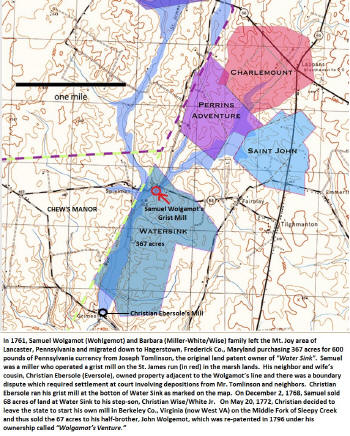 That
same year, Christian White was 21-22 years of age and mother Barbara and
stepfather sold him a parcel of land for 300 pounds currency at Water Sink
on December 2, 1768.
That
same year, Christian White was 21-22 years of age and mother Barbara and
stepfather sold him a parcel of land for 300 pounds currency at Water Sink
on December 2, 1768.
"Dec 1768 ...at the request of Christian Wise the following
deed was recorded. Land called Water Sink sold to Christian Wise by Samuel
Wolgamot."
SOURCE: Frederick Co., Maryland
Land records:
Book L, page 596.
This transaction proved first that Christian was
at least 21 years old since that was the minimum age to own
property in Maryland and second, that mother Barbara was still alive as
she was named in the land transaction. The parcel was a carve out
from Samuel's original parcel 3 miles south of Hagerstown near the Potomac River
(see Map Water Sink map). It was around that time Christian
joined families with the Stonebreakers of Funkstown, Maryland. He married
Elizabeth Stonebraker around 1769 and she gave birth to their first born,
John, in 1770*. There is no marriage record found for Christian and
Elizabeth, but I am estimating their marriage based on the birth of John. Also, there is no birth record for Elizabeth, but I am
estimating her birth year about 1753 as she would be age 17 with the birth
of John and age 47 with the birth of her youngest child, Samuel, in
1800.
*1840 and 1850 Washington Co., TN
Census records show that
John White (1770-1850)
was born about 1770.
The parents of Elizabeth Stonebraker are not
proven however, there is a strong lead that she was the daughter of
Michael Stonebraker (b. 1720), son of Danish emigrant, Christian
Stonebreaker, who came to colonial America in 1730 with his three sons and settled in the Funkstown District
just south of Hagerstown. "The
letter patents for their land dated 1730 are still in the possession of
their descendants.*" According to "The Stonebrakers in
America" by Dr. Charles L. Eater, Jr., et al, 1992., he places
Michael Stonebraker as the probable 2nd son of Christian Stonebraker and
Michael's first born was Garrett/Gerard (b. 1742 - d. June 1813).
According to Gerard Stonebraker's Will, he owned a large sum money and
property to include a vineyard in Funkstown. Therefore, it is my thought
that
Elizabeth (b. 1753) would be the likely younger sister of Gerard since it
is proven that Gerard's son, Michael Stonebraker (named after his
grandfather), married Christian White's
half-sister, Esther S. Wohlgemot about 1783.
"Shortly before the close of the
Revolutionary War, Michael Stonebraker located on the Potomac river, near
where Bakersville now stands, and in 1792 became possessed of a large
tract of land, where he raised his 4 sons and 4 daughters.** Their plantation was outside of Bakersville, Maryland 3 miles from Water
Sink where the Wohlgemots lived.
* SOURCE:
A History of Washington County Maryland -Vol. 2, by Thomas C J. Williams,
Baltimore, MD, 1906 pg. 898
** SOURCE: "A Rebel of '61" by
Joseph R. Stonebraker, Wynkoop Hollenbeck Crawford Co. Printers,
NY-Albany, 1899, pgs 14-15.
NOTE: Michael and Esther Wolgemot-Stonebraker are buried at Eakles Crossroads near Sharpsburg at
Salem Evangelical Lutheran Church, Bakersville Cemetery, Washington
Co., Maryland. Michael Stonebraker was a Trustee** when they broke
ground on Feb. 1, 1810 to build a meeting house of worship with adjacent
burial grounds. Their tombstone state "Michael Stonebreaker who died
May 6th 1815 in the 56 years of his Age" (1759-1815); In Memory of
Ester, Wife of Michael Stonebraker, Born Dec. 27, 1762 - Died Feb. 17,
1827. Esther died at age 64.
**Source: Centennial History of the Evangelical Lutheran Synod in Maryland
1820-1920, Wentz.
Samuel and Barbara Miller-White-Wohlgemuth lived
the rest of their lives at Water Sink operating their mills on the
St. James run in the mash lands of Frederick Co., (now Washington Co.)
Maryland. He also purchased 400 acres of land in the western frontier of Monongalia Co., Virginia (now West VA) for his two married daughters, Franny and Esther, to
set up their homesteads. Esther most likely sold her portion as she
married Michael Stonebraker and remained in Bakersville until death. There is no death certificate found for Barbara
but she most likely died several years before Samuel
remarried to a Catherine who was named in his Will written on April 18,
1789, and proved on June 20, 1789. As Barbara may have predicted,
Samuel did not name Christian, Barbara and Magdalena White in his Will. The witnesses
give strong suspicion that Samuel may have been a Dunkard Brethren. The Will stated:
"Catherine and my four children: John,
Mary, Esther and Frony. Inheritance of my daughters Easter and
Franny be used to buy land for their children. My 400 acres in
Monongahle [sic]
Co., Virginia bought from Francis Deakin,
200 acres to Easter Stonebraker, 200 acres to Frany Maxel, married
daughters." Signed Samuel Wolgamoth
Witnesses: Peter Sight, Samuel Bachtel, and Jacob Zug [Tug]."
SOURCE/NOTE: Frederick Co., MD Wills.
His Will states 3 men "of his Society" are to appraise his estate. Samuel Bachtel was a German
Baptist Brethren (Dunkard) Minister and Jacob Zug was a Dunker member of the
White Oak Church of the Brethren. Members of church were referred to
as a Society. Jacob Zug sold his farm in
the Conestoga area of Lancaster, PA and moved down to the Water Sink
(marsh lands) area and purchased 228 acres from Samuel Wohlgemuth on March
12, 1774. The 228 acres were situated "on the Waters of the Great
Marsh falling out of his Lordship's Manor Conogocheague into the Potomack
River and joining to a tract of land called the Chews farm," and
included a part of another tract called "Nullum Lookout." The farm is
about eight miles southwest of Hagerstown, near land patent "Fairplay."
According to the"Zuck Genealogy" by John B. Zuck, Jacob Zug was the oldest
son of White Oak Minister, Ulrich Zug and after Jacob's death on
January 17, 1792, his farm at Water Sink was sold to his son -in-law,
Nicholas Martin, and John Wolgemot (Samuel's son).
On May 20, 1772,
Christian White Jr. sold the 67 acre parcel in Water Sink to his half-brother, John
"Wilgamott" for 350 pound currency. Per the Frederick Co.,
Maryland land records: "sold to John Wilgamott for
350 pounds, 62 acres, signed by Christian WeiB, witnessed by Thomas
Prather and Basil Prather, deed recorded 22 June 1772.
SOURCE: Frederick Co., MD. Deed Book
P, page 231. Land indenture Christian Wise to John Wolgamot June 1772.
NOTE: John Wolgemot partnered with his father Samuel on milling
endeavors to grist, lumber and distillery operations which flourished at
Water Sink. Joseph's parcel was a carve out of Water Sink and after
his father's death, he patented his land called "Wolgemots Venture."
After selling
his land in Maryland, Christian's family and Gaspar Stonebraker family moved across the Potomac River into Berkeley
Co., Virginia (now Morgan Co., West Virginia) about 40 miles southwest to the Middle Fork of
Sleepy Creek to start their grist mill. As explained earlier,
Christian's half-sister, Esther Wolgemot, married
Michael Stonebraker, the likely nephew to Christian’s
wife Elizabeth Stonebraker. Also, Gaspar/Casper Stonebraker is the probable brother to Elizabeth and he married a Barbara
which many researchers believe is Christian's full-blood sister since Gaspar and Christian partnered together in acquiring 393 acres as joint
owners on the "North Fork" of Sleepy Creek. The land was surveyed and
a warrant executed on July 7, 1772, and entered into the books in March
28, 1775. On April 2, 1771, Wendle Frushour of Frederick Co.,
Virginia requested a warrant, #338, to be executed on behalf of "Christian
White and Gaspard Stonebraker" of Frederick Co., Maryland, a plat for 393
3/4 acres. Based on this, it was evident that Christian was planning
to leave Water Sink a year before he sold his land to his half brother.
It also showed that he and Gaspar were acquainted with Wendle Frushour and
used him to assist in their land acquisition at Sleepy Creek. Berkeley Co.
VA was established on February 10, 1772, from Frederick County, VA.
"P340: Caspar Stonebraker and Christian White both of Berkeley
Co., assignees of Wendle Froshour, 393 acres on North Fork of Sleepy Creek
in said county. Surveyor Richard Rigg. Adj. William Bailey's Dark
Lick Survey. 28 March 1775.
SOURCE: "Virginia Northern Neck Land
Grants, 1742-1775, Volume 2." By Gertrude E. Gray. pg. 229.
Johann Wendel Frushour (1722-1793) was a
Palatine emigrant who settled in Sleepy Creek area near present day
Berkeley Springs, West VA. He owned 2 tracts of land - one of which
was 400 acres and the other 140 acres.
http://midatlantic.rootsweb.ancestry.com/familyhart/documents/Sturm/SturmBook-JacobSturmGenealogy.pdf
pg. 29
Christian White
Jr. and
Gaspar Stonebraker families lived on this land until
August 1779, when they sold the parcel to William Catlett for 360 pounds
currency.
"R-273: William Catlett of
Berkeley County, assignee of Christian White for whom surveyed 145 acres
on Middle South Fork of Sleepy Creek. Surveyor Richard Rigg, Adj. Gasper
Stonebraker, His Lordship's Line, Michael Pyke, Edward Crabb. August
23, 1779."
SOURCE: "Virginia Northern Neck Land
Grants, 1775-1800, Volume 3"By Gertrude E. Gray, Dave Gray, pg. 38
"Indenture 17 Aug. 1779 Between Christian White and Casper Stonebraker of Berkeley Co. Va., grantors to William Catlett For 200
pounds a tract of land lying on the waters of Sleepy Creek; granted to
White and Stonebraker by patent of 1775.
Christian White and Elizabeth his
wife, Casper Stonebraker and his wife Barbara to William Catlett"
SOURCE: Berkeley Co., West Virginia
Court Records and Deed Book 5 Page 295-296.
NOTE: William Catlett sold the 285 1/2
property in 1789, to Hubbard Hume and the record showed that the property
was located on the "drains of Sleepy Creek". Drains from rivers are
used to operate mills.
Berkeley Co VA Rent Rolls (1774 - 1781):
White and Stonebreaker, 393 acres. Land patented in 1775 by Christian
White w/ Gaspard Stonebreaker. 1779 Same land sold.
The Revolutionary War
was stirring up Christian and Gaspar were chain carriers on a resurvey of land for Edward Crabb of Sleepy Creek
in July 1776, the time when Colonial America declared its Independence
from England. Christian would be about 31 and still young
enough to serve but it is unknown if either Gaspar or Christian
participated in any militias.
"Edward Crabb, 7-13-1776 through 11-7-1776 432 acres to amend an
error in his 202 acre surveying land on Middle South Fork of Sleepy Creek.
William Bailey & Bartholomew Fryett, Stonebraker, Stephen Mill
chain carriers: Gaspar Stonebraker & Christian White.
SOURCE: Berkeley Co., West Virginia
Court Records and Deed Book 4 Page 83
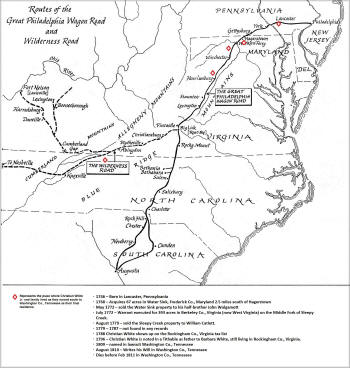 Sometime
after 1779, Christian
White, Jr. and Gaspar Stonebraker parted ways and Christian and family moved further south
via the Great Wagon road to the
Harrisonburg area of Virginia.
Two of Christian's grandmother's siblings, Christina Kneisley-Haldiman and
Antonius Kristopher Kneisley Jr. had already settled in the
Woodstock area of northern Virginia after 1735. Also, Christian's mother's
brother, David Miller, also moved down the Harrisonburg area of Virginia
after the death of his mother, Barbara Kneisley-Miller-Woolslegle in 1777.
Samuel Miller purchased land in 1782 and additional land in 1785 2 miles
west of Harrisonburg and died in 1789 with his son taking over the Estate.
Christian went missing in records from 1780 until 1788 which leads me to
believe he and family may have been living with his uncle David Miller a
time until he established his own residence and was taxed in 1788, on the
Tenth Legion* of Rockingham Co., Virginia tax list. Also noted in that same tax roster
was
Abraham Odle / Odell. Christian’s son, John, ended up marrying Abraham Odell’s daughter,
Margaret, when they arrived in the Leesburg area (5 miles west of
Jonesborough) of Washington Co.,
Tennessee. A Christian “Weit” was noted in a 1796 Rockingham
Co., Virginia "tithable" as "father of Barbara White" who married
James Sellers. When looking more closely at the relationship of
Barbara and James and the Sellers / Zeller line, it reveals clues as to
how they met and the location of where the Christian White clan lived in
Rockingham Co., VA. According to the
1792 Tenth Legion Tithables, Rockingham Co., VA Tax Roster, "Chrisly White"
was noted in the 8th District under Josiah Harrison's Co. with 6 taxables in the household and living
next door to Henry Kinder on one side and Isaac Wiseman on the other.
In that same district was Conrad Sellers (uncle of James Sellers) and
Abraham Odle. My deduction is that the couple met through the
Methodist church affiliations. Furthermore, James Sellers' first
cousin, Ann Sellers (d/o Conrad Sellers and Elizabeth Helfry) married
Joseph White on August 1, 1805, in Rockingham Co., VA and it is suspected
that this Joseph White (b. abt. 1782) is the brother of Barbara White.
James Sellers' father, Johann Michel
"Michael" Zeller/Sellers constructed a meeting house on his property
located at present day Melrose Caverns, Virginia (abt. 8 miles north of
Harrisonburg, VA, off US Hwy 11 and I-81) for Methodist Circuit riders to conduct
services. Furthermore, the Zeller family moved to Rockingham Co.,
Virginia from Lancaster, PA and were German immigrants.
Sometime
after 1779, Christian
White, Jr. and Gaspar Stonebraker parted ways and Christian and family moved further south
via the Great Wagon road to the
Harrisonburg area of Virginia.
Two of Christian's grandmother's siblings, Christina Kneisley-Haldiman and
Antonius Kristopher Kneisley Jr. had already settled in the
Woodstock area of northern Virginia after 1735. Also, Christian's mother's
brother, David Miller, also moved down the Harrisonburg area of Virginia
after the death of his mother, Barbara Kneisley-Miller-Woolslegle in 1777.
Samuel Miller purchased land in 1782 and additional land in 1785 2 miles
west of Harrisonburg and died in 1789 with his son taking over the Estate.
Christian went missing in records from 1780 until 1788 which leads me to
believe he and family may have been living with his uncle David Miller a
time until he established his own residence and was taxed in 1788, on the
Tenth Legion* of Rockingham Co., Virginia tax list. Also noted in that same tax roster
was
Abraham Odle / Odell. Christian’s son, John, ended up marrying Abraham Odell’s daughter,
Margaret, when they arrived in the Leesburg area (5 miles west of
Jonesborough) of Washington Co.,
Tennessee. A Christian “Weit” was noted in a 1796 Rockingham
Co., Virginia "tithable" as "father of Barbara White" who married
James Sellers. When looking more closely at the relationship of
Barbara and James and the Sellers / Zeller line, it reveals clues as to
how they met and the location of where the Christian White clan lived in
Rockingham Co., VA. According to the
1792 Tenth Legion Tithables, Rockingham Co., VA Tax Roster, "Chrisly White"
was noted in the 8th District under Josiah Harrison's Co. with 6 taxables in the household and living
next door to Henry Kinder on one side and Isaac Wiseman on the other.
In that same district was Conrad Sellers (uncle of James Sellers) and
Abraham Odle. My deduction is that the couple met through the
Methodist church affiliations. Furthermore, James Sellers' first
cousin, Ann Sellers (d/o Conrad Sellers and Elizabeth Helfry) married
Joseph White on August 1, 1805, in Rockingham Co., VA and it is suspected
that this Joseph White (b. abt. 1782) is the brother of Barbara White.
James Sellers' father, Johann Michel
"Michael" Zeller/Sellers constructed a meeting house on his property
located at present day Melrose Caverns, Virginia (abt. 8 miles north of
Harrisonburg, VA, off US Hwy 11 and I-81) for Methodist Circuit riders to conduct
services. Furthermore, the Zeller family moved to Rockingham Co.,
Virginia from Lancaster, PA and were German immigrants.
* Tenth Legion comes from the
coined term by then Governor Thomas Jefferson "Old Tenth Legion of
Democracy" which afforded people religious freedom, pro democracy and was
against slavery in an area that comprised of Rockingham, Shenandoah and
Page Counties of Virginia. The Massanutten region (Zenda)
is where Christian White, Jr. clan lived for about 12 years. This
area was predominately settled by a large influx of Pennsylvania Pilgrims
(many of whom were German)
seeking religious tolerance in the fertile lands of now Harrisonburg, VA
area. There are 7 well known grottoes in the vicinity.
Source
"Massanutten Settled by The Pennsylvania Pilgrim 1726", by
Harry M. Strickler, 1924.
More info: SELLERS-WHITE
Around 1794, Abraham Odle/Odell
moved down to Washington Co., Tennessee. The Christian White family
followed a few years later via the
Great
Philadelphia Wagon Road to the Wilderness Road towards Jonesboro
settling in the Leesburg area 5 miles outside of Jonesborough. Although there is no record available to prove the date
when Christian White Jr. and family moved down to Tennessee, I am dating
their migration around 1800, shortly after the birth of their youngest
child, Samuel L. Census records show
that Sam was born about 1800 in Virginia (mother Elizabeth would be about 48
which seems a bit old for pregnancy although not impossible).
According to
Samuel Lewis White's obituary, he was
born in 1803 and died at age 72 in
December of 1875 and buried at the
Hamden Cemetery in Zaleski, Vinton, Ohio. I believe the
age noted in the obituary was an estimate and he was actually born about
1800 as shown in the 1850 / 1860 census records and the age of his mother.
Samuel's son,
Charles L. White's obituary of 1902 stated he was the grandson of
Christian White and Elizabeth and wrote in a separate document that:
"Christian and Elizabeth
White migrated from Germany about the year 1750 and settled in Lancaster
and afterwards Berks Co., PA, subsequently moving to Shenandoah Co.,
Virginia and thence to Leesburg, Washington Co., east Tennessee."
SOURCE: Page 5, "Christian White,
Lancaster Co., PA, Christian White, Wash., Co., TN" by Pauline R. Crader, May 1998.
Also referenced in the following Bio of Charles L. White. I believe
"Berks Co., PA" was a mistake in the transcription and was supposed to be
"Berkley Co., VA" since that was where Christian White and family lived
for a time when they
left Lancaster, PA to
Watersink outside of Hagerstown, Maryland. Berks Co., PA is the
Reading area east of Lancaster which is not in the migration path of
Christian White.
Charles Lewis White and John Fletcher White
were the sons of Samuel Lewis White and Elizabeth Wilson Masterson.
Both were well educated men who served in the civil war; one became a
lawyer and the other a physician.
BIO -
CHARLES L. WHITE, ESQ.
BIO - JOHN FLETCHER WHITE, MD
In 1809, Christian White was found in a lawsuit in
Washington Co., Tennessee vs. William Purcell /Pursley) Sr. and George
House regarding bail for a Joseph Glass with a judgment that Glass pay White
$134 dollars. There are no census records available for 1800, 1810,
and 1820 for Washington Co., Tennessee so we do not get to see the time of
when the children split up, some of whom remained in Washington Co.,
Tennessee and others migrated to Ohio, Illinois, Indiana and Iowa.
Christian White Jr. wrote his Last Will and Testament
on May 29, 1810, bequeathing everything to his “true and loving wife
Elizabeth”. It does not appear Christian was able to read or
write since he placed an "X" by his name. The Will went into Probate
on August 8, 1810, which means Christian died sometime before August. The Will was proven in court with William Sands and
Christian Zetty as witnesses in the February Session 1811, Washington Co.,
Tennessee. Elizabeth lived another 30 years and is noted in the
1830 (70-80 age group) and 1840 (90-100 age group) Washington Co.,
Tennessee censuses living with her son John in the Greasy Cove area of now
Unicoi Co., Tennessee. She never
remarried. Christian and Elizabeth Stonebraker-White's burials
are unknown. I suspect Christian's grave to be located in the
Leesburg /Telford area of Jonesborough and wife, Elizabeth's, around the present
day Fishery area of Unicoi Co. where her John, son owned a large parcel of
land. As a side note, I believe that
Christian White was well acquainted with Christian Zetty, the witness to
his Will. They had similar backgrounds in that Christian Zetty (b.
1762 - d. 1841 of German ancestry) was born in Donegal, Lancaster, PA, same town where Christian White was born, migrated down to the
Harrisonburg area of Rockingham Co., VA with his parents in the late
1700's and then moved onward to the Jonesborough area of Washington Co.,
Tennessee. Christian Zetty was the son of Peter Zetty/Zette and
Barbara Ann Reiff and married Barbara Miller in Rockingham Co., VA. Zetty's wife may be related to Christian White Jr. since his mother was
also Barbara Miller of Donegal Twp., Lancaster, PA.
“In the name of God, Amen:
Whereas it being appointed for all men to die and at this time being
weak in body but of sound mind and memory and having some worldly property
which I do dispose of in the following manner concerning of which I do
make and ordain this to be my last will and testament. In the first
place I do ordain and name especially and absolutely appoint my true and
loving wife Elizabeth to be my sole executor and I do give and bequeath to
her all and singular all my worldly property to be disposed of among my
heirs at her discretion and at any time she may think proper before or at
her death. In testimony whereof I have hereunto subscribed my hand and
seal the twenty ninth day of May in the year one thousand eight hundred
and ten.
His
Christian “X” White (( Seal ))
mark
Test.
William
Sands )
Christian
Zetty )
The
foregoing Will was proven in court by the oaths of William Sands and
Christian Zetty the subscribing witnesses thereto at February Session
1811 and ordered to be recorded. Elizabeth White qualified as Executrix of
the foregoing will."
